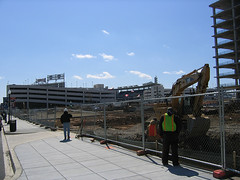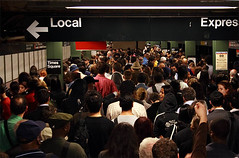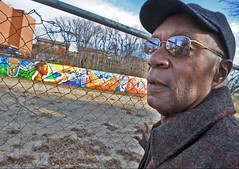Building slump hampers both smart growth and sprawl; transit soars despite lower fuel prices

Posted December 3, 2008 at 1:45PM
One of the things that has concerned me about the recession, and in particular how hard the building industry has been hit, is that a lot of ready-to-go smart growth projects will have trouble securing financing, buyers, and tenants. A page-one story in Tuesday's Washington Post by Paul Schwartzman and Dana Hedgpeth confirms that the worry has been well-placed.
 Among the setbacks in the DC area are the new development planned around the Washington Nationals' baseball stadium, redevelopment of the old industrial neighborhood north of Union Station, conversion of a dilapidated suburban strip in Prince George's County, Maryland, and the new mixed-use center planned for the old Washington Convention Center site a block east of my office. Schwartzman and Hedgpeth report that as recently as three years ago, the number of housing units authorized across the DC metro region had reached 41,221, but the number of authorized housing units fell to 16,434 this year, the lowest level since 1991. Commercial building has declined from 17 million square feet of office space construction begun two years ago, to only 4 million this year.
Among the setbacks in the DC area are the new development planned around the Washington Nationals' baseball stadium, redevelopment of the old industrial neighborhood north of Union Station, conversion of a dilapidated suburban strip in Prince George's County, Maryland, and the new mixed-use center planned for the old Washington Convention Center site a block east of my office. Schwartzman and Hedgpeth report that as recently as three years ago, the number of housing units authorized across the DC metro region had reached 41,221, but the number of authorized housing units fell to 16,434 this year, the lowest level since 1991. Commercial building has declined from 17 million square feet of office space construction begun two years ago, to only 4 million this year.
The silver lining is that sprawl development is facing the same difficulties. Other troubled projects cited in the article include the conversion of farmland in outlying Gaithersburg and "a marina and a golf course designed by Jack Nicklaus, all of it on nearly 2,000 virgin acres in Prince William County [Virginia]." Perhaps the delay will allow time for some of those projects to be reconsidered or improved, and I believe that the higher values that consumers are placing on more centrally located, transit-accessible locations will allow the smart projects to recover sooner. Click on the photo below for a slideshow of related photographs on the Post's website:
More encouraging is the news that the recent decline in gasoline prices has not led to a decline in public transit usage, which continues to boom. Transit usage in the DC area is up three to five percent from the same time period last year. In Dallas, it is up 12 percent. And, in Orange County, California, the transit agency reported 6.3 million bus boardings in October, the highest in the agency's history.  Commuter rail and express bus usage from Washington-area exurbs is up 7 to 25 percent, depending on the route, from the same month last year.
Commuter rail and express bus usage from Washington-area exurbs is up 7 to 25 percent, depending on the route, from the same month last year.
This is consistent with my report last week that driving in the US has remained in decline despite the recent easing of fuel prices. It's a nice problem to have, but now the worry is whether transit agencies will be able to keep up with surging demand on already-strained systems (see photo of Times Square subway station in New York).
